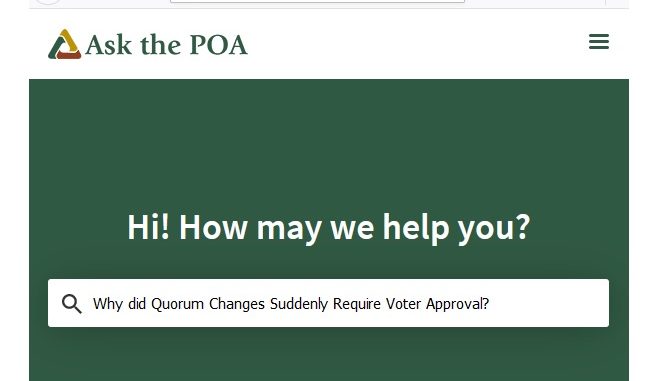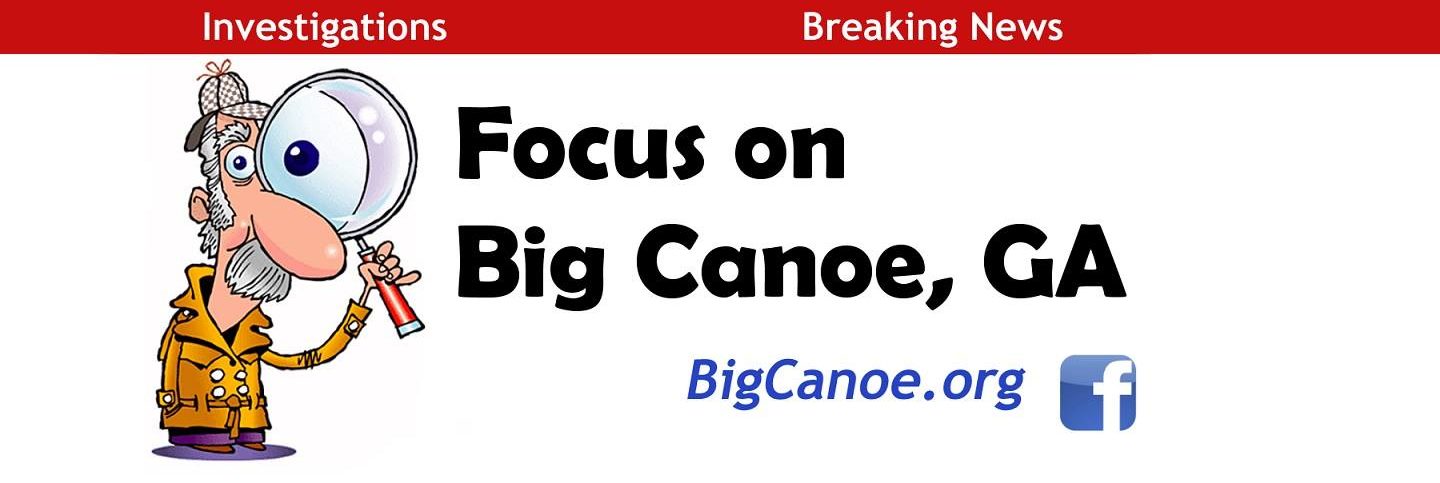
As a 20+ year resident of Big Canoe, and as a Property Owner within Big Canoe, I have just submitted a series of questions through the Big Canoe “Ask the POA” site.
As the Newspaper Publisher of “Focus On Big Canoe“, I believe the questions may be of interest to all Property Owners, and as such I have copied my correspondence below.
Begin Copy of Letter to Ask The POA:
UPDATE 12-04-2020: POA General Manager Scott Auer issued a “response”. I have followed up with two (2) clarifying responses of my own. Then he responded again, and I concluded. Not sure this is going anywhere. It is what it is. The entire transcript of these additional responses can be read in the following 4 Pg PDF ~ AskThePOA-Ticket2055_FollowupResponses2.pdf
(Ask The POA / Ticket # 2005 Submitted on 2020-12-01)
Greetings,
I am currently reviewing my 2020 Ballot for Directors, and my Proxy for the 2020 Annual Meeting. Both Documents have a Section which provides an option to Vote on the following (excerpted):
> YES, I approve the lowering of the quorum to as low as twenty-five percent (25%), if needed, to hold an official Annual Meeting and Election
> NO, I do NOT approve of lowering the quorum
The above “Yes/No Quorum Reduction Vote” within the Ballot for Elected Directors, appears to be a completely separate “Vote within a Vote”. The “Yes/No Quorum Reduction Vote” actually affects the separate “Ballot Vote” for elected Director. The “Yes/No Quorum Reduction Vote” within the Annual Meeting Proxy also affects the legitimacy of the Annual Meeting, and any actions taken as a part thereof.
In regards to the above separate “Yes/No Quorum Reduction Vote”, I have the following questions:
(1) What State Law, Covenant Section, By-Law language, and/or other guidance specifically are you relying on to guide, and authorize, you in setting forth this separate “Yes/No Quorum Reduction Vote”?
(2) What Membership Quorom Percentage, and Yes/No Voter Percentage, are established as the minimum threshhold for approval / dissaproval for reducing, or not reducing, the Quorums as presented in this separate “Yes/No Quorum Reduction Vote” within the Ballot and Proxy documents?
(3) What “member population” are you using as a reference from which to establish a Quorum for the Approval/Rejection of this separate “Yes/No Quorum Reduction Vote”? Also, please provide the exact State, Covenant, or By-Law section that applies.
a. ALL Members of the Big Canoe Property Owners Association (“BCPOA”)
b. ALL Members “Eligible to Vote” at the time of this Ballot & Proxy“Yes/No Quorum Reduction Vote” being provided?
c. ALL Members who return a Ballot or Proxy?
d. All Members “Eligible to Vote” at the time of this Ballot & Proxy Vote being provided, who return a Ballot or Proxy?
e. Other (Please Explain) ___________________________________________________
________________________________________________________________________
(4) What are the exact parameters for establishing “Voter Eligibility” for this separate “Yes/No Quorum Reduction Vote”? If specific dates or conditions must have been met, please provide these.
Before I ask my next questions, I would like to offer some perspective and history that need to be taken into consideration before providing an answer. I corresponded with the BCPOA Board, Management, and Attorney regarding this same matter of Quorum reduction in the 2020 Creek 9 Renovation Vote. The following was a response provided to me in a Sept 29, 2020 letter from the BCPOA Attorney, Kim C. Gaddis (of Gaddis & Lanier LLC):
“The Bylaws for Big Canoe expressly provide for this tiered quorum and for this adjourning and reconvening process that 35% of the eligible votes must be represented in person or by proxy at the first call of a meeting, but that if for any reason this quorum requirement is not met at that first meeting, the Bylaws expressly authorize persons representing a majority of the votes cast at the first meeting to “adjourn” such meeting and to reconvene at a second meeting (which can be the same day as the first, or up to 45-days later), at which second meeting the quorum requirement is reduced to 30% of the eligible votes of the Association.”
Also stated in her letter as explanation for why this language was put into the Golf Renovation Ballot was the following:
“ However, in an effort to be overly transparent and so as to allow all Owners to completely understand the voting requirements and process, the Big Canoe Board included in this most recent voting package and Ballot a recitation of the wording of the tiered Bylaws quorum requirements, and included as part of the vote each Owners’ express authorization and agreement to the adjournment and reconvening of a meeting process as outlined in the Bylaws allowing the Association to reach the 25% minimum quorum requirement, if needed. You are obviously well aware of the Ballot’s verbiage on Page 2 which indicates that by signing the Ballot you, as a Member of the Association, are agreeing to the adjournment and reconvening of the “meeting” at which this vote would take place were it to be in person…..”
I would like to point out that the “voting requirement and process” appears to have changed in the short period of time since the Creek 9 Renovation Vote. What was then “expressly provided” for, now seems to require specific Member Authorization via this new and separate “Yes/No Quorum Reduction Vote”. My questions in relation to this are as follows:
(5) In regards to the addition of this new “Yes/No Quorum Reduction Vote” option to approve or disapprove lowering the quorum in a vote or meeting, by an automatic “adjourning and reconvening process”, I ask the following:
a. What has legally changed since the Creek 9 Renovation Vote, that this new “Yes/No Quorum Reduction Vote” Option has been added?
b. If this is a legal requirement now, why was it not a legal requirement in the Creek 9 Renovation Vote?
c. If this was not a legal requirement in the Creek 9 Renovation Vote, and is also not an actual legal Requirement in this current Ballot Vote and Meeting Proxy, then why is it being entered into the language at all? Wouldn’t that create a legal jeopardy to the validity of the Ballot Vote, or Meeting Proxy?
CLOSING COMMENT / FINAL QUESTIONS:
This new “Yes/No Quorum Reduction Vote” appears to go well beyond simply “an effort to be overly transparent”, and is clearly the introduction of a new and inconsistent legal process, within the larger voting and meeting processes. As a property owner I am concerned that the Voting Process has recently been subject to whimsical changes that are not grounded in any legal basis, which brings me to my final questions:
(6) Did any representative of the BCPOA seek, or receive, legal guidance on this change to add the “Yes/No Quorum Reduction Vote” language? If so, will you share a copy of that legal opinion / guidance?
(7) Who was responsible for the additions of the “Yes/No Quorum Reduction Vote” options in the recent Directors Election Ballot and Annual Meeting Proxy? Management? Election Committee? BCPOA Attorney? BCPOA Board? Other?
(8) Were the additions of the “Yes/No Quorum Reduction Vote” options discussed or approved by the Board? Did the Board vote on the addition of the “Yes/No Quorum Reduction Vote” option? Did any Committees vote on the addition of the “Yes/No Quorum Reduction Vote” option?
(9) Is the discussion and/or approval of the additions of the “Yes/No Quorum Reduction Vote” options into the Ballot and Proxy reflected in any Minutes or Notes of Meeting (i.e. Board of Directors? Committees?) If yes, can and will you provide me, or direct me via link to, copies of such?
(10) LAST QUESTION: The “Yes/No Quorum Reduction Vote” is duplicated in 2 separate documents: (a) the Ballot, and (b) the Proxy. Can you please describe the significance of how each will be used in differing fashion, and why separate Ballot & Proxy “Yes/No Quorum Reduction Vote” are required?
Thank you in advance for your answers to my questions.
Sincerely,
david hopkins
property owner of lot 4002
10887 Big Canoe
Big Canoe, GA 30143
themtnsvoice@aol.com




Be the first to comment